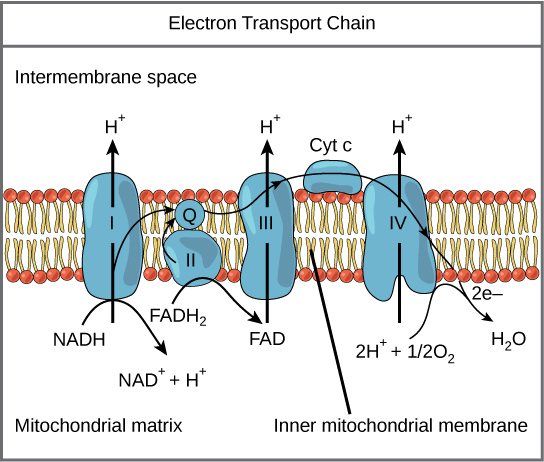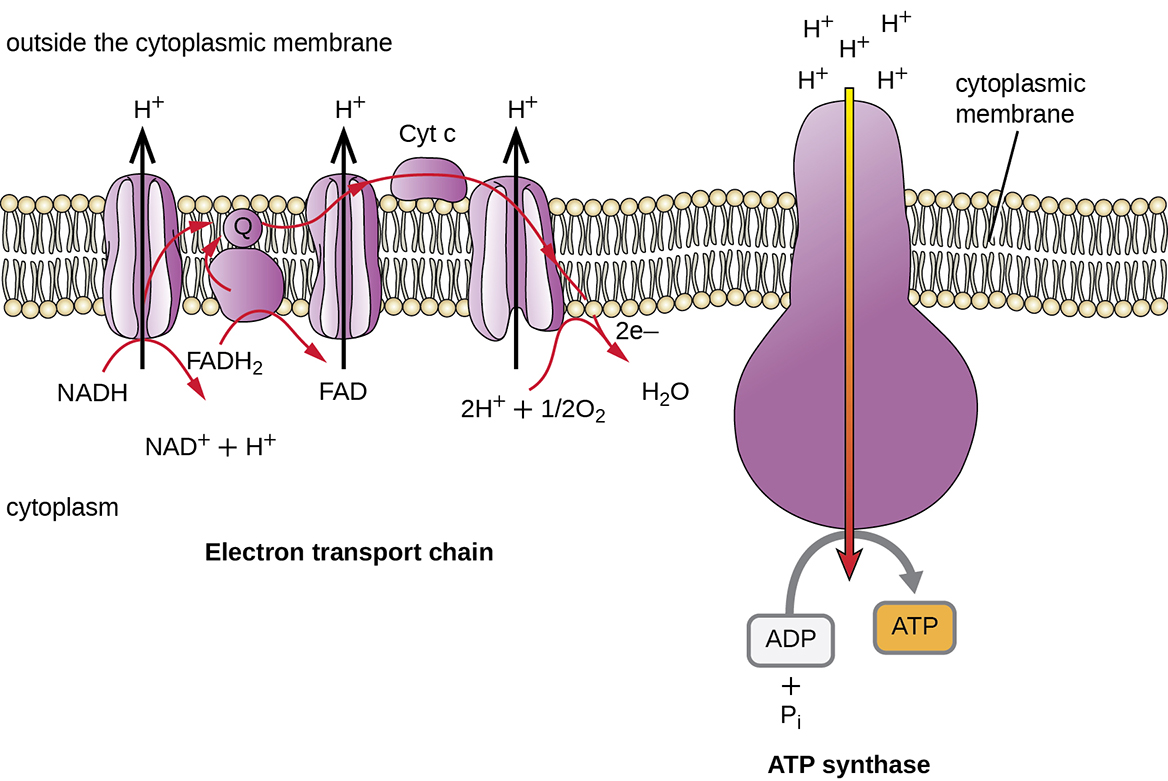Final Electron Acceptor in Aerobic Respiration
For the electron transport chain to continue working there must be a final electron acceptor. My point is that in living cells a current can be a positive charge moving down a gradient driving a molecular machine.

During Aerobic Respiration The Final Electron Acceptor Is
Anaerobic respiration also produces less ATP for each sugar molecule digested than aerobic respiration making it a less efficient method of generating cellular energy.

. Organisms such as these produce odoriferous gases in their metabolism including hydrogen sulfide gas and methane. NO 3 NO 2 NO N 2 O N 2This dissimilatory process the end product is not assimilated into biomass in which nitrate is used as final electron acceptor in anaerobic respiration is. But where does it exactly fit in the picture.
In this reaction lactic acid replaces oxygen as the final electron acceptor. However anaerobic respiration is important for biogeochemical cycles of elements like sulfur carbon and nitrogen. Anaerobic respiration occurs in most cells of the body when oxygen is limited or mitochondria are absent or nonfunctional.
However some types of organisms. Oxygen is the final electron acceptor in aerobic respiration. Metabolic poisons such as cyanide disrupt oxidative.
How do you want to study today. Upgrade to remove ads. This transfer of electrons from lower to higher redox potential continues until it reaches the final electron acceptor.
If you want any Q. Cellular respiration may be described as a set of metabolic reactions and processes that take place in the cells of organisms to convert chemical energy from. Different types of organisms use different types of final electron acceptors.
This is an effective pathway of ATP production. Since you have asked multiple question we will solve the first question for you. Cellular respiration is of two types ie.
Oxygen combines with electrons and hydrogen ions to form water one of the products of aerobic respiration. The electrons are passed onto electron carriers which are embedded within the inner mitochondrial membrane and travel along a series of. If that acceptor is oxygen the process is considered aerobic respiration.
Basically oxygen can be found at the end of the ETC during aerobic respiration where it accepts electrons while picking up protons in order to produce water molecules. It is a process when glucose is broken down in the absence of oxygen. The electrons are accepted by oxygen which also accepts the hydrogens we actually call oxygen the final electron acceptor in aerobic respiration but it accepts hydrogens as well and becomes water.
Methanogenic bacteria are one such type of organisms that use carbon dioxide as the final electron acceptor in the absence of oxygen. Carbon dioxide C A. Anaerobic respiration is less efficient than aerobic respiration because the final electron acceptor in anaerobic respiration has a smaller reduction potential than oxygen molecules.
Biology 103 FINAL EXAM. What process produces large numbers of ATP. The series of reactions is typically shorter in anaerobic respiration and uses a final electron acceptor such as sulfate nitrate sulfur or fumarate instead of oxygen.
Which is referred to as the final electron acceptor. These can be sulfate ions nitrate ions or carbon dioxide. O photosynthesis O cellular respiration O pyruvate A.
While respiration can be represented as the simple combustion of carbohydrates to form carbon dioxide and water the cell cannot afford to release all the chemical energy stored in carbohydrates in a single step since it would irreversibly damage the intricate balance and. In aerobic respiration molecular O 2 serves as the terminal acceptor of electrons. It is a process when glucose is broken down to carbon dioxide in the presence of oxygen to produce energy in the form of ATP.
Final exam study guide for Biology 103 Principles of Biology Learn with flashcards games and more for free. The complexes involved in the electron transport. Oxidative phosphorylation is the fourth and final step in cellular respiration.
Madsen in Encyclopedia of Ecology 2008 Denitrification. Aerobic respiration and anaerobic respiration. ATP adenosine triphosphate is the source of energy at the cellular level for.
For example because erythrocytes red blood cells lack mitochondria they must produce their ATP from anaerobic respiration. In the electron transport chain electrons from NADH and FADH2 are transferred to an electron acceptor having a higher redox potential. The oxygen is the final electron acceptor of what is known as the electron transport chain found in the last stage oxidative phosphorylation of aerobic cellular respiration.
The electron carriers deposit the electrons at the beginning of the chain and then through a process called chemiosmosis produce many ATP. Oxygen is an essential molecule in cellular respiration. It is also called fermentation.
For aerobic organisms oxygen is an absolute requirement for their energy-yielding properties. Respiration takes place when any organic compound usually carbohydrate is oxidized completely to CO 2 and H 2 O. For anaerobic respiration NO 3 SO 4 2 CO 2 or fumarate can serve as terminal electron acceptors rather than O 2 depending on the.
The final electron acceptor is not the molecular oxygen as in aerobic respiration. Study sets textbooks questions. The terms aerobic respiration anaerobic respiration and fermentation substrate-level phosphorylation do not refer to primary nutritional groups but simply reflect the different use of possible electron acceptors in particular organisms such as O 2 in aerobic respiration or nitrate NO 3 sulfate SO 2 4 or fumarate in anaerobic respiration or various metabolic.
Which is the final electron acceptor in aerobic respiration. Certain microorganisms grow in oxygen-free environments and are described as anaerobic. Review terms and definitions.
Oxygen provides a force to drive the transport of electrons down the chain. Cellular respiration is the process by which biological fuels are oxidised in the presence of an inorganic electron acceptor such as oxygen to produce large amounts of energy to drive the bulk production of ATP. Denitrification is an anaerobic process which converts nitrate to dinitrogen in the following sequence.
Because of this oxygen is also called as the final electron acceptor. The process of anaerobic respiration takes place in the.
What Is The Terminal Electron Acceptor In Aerobic Cellular Respiration Quora

Electron Transport Ck 12 Foundation
What Is The Final Acceptor Of Electrons Stripped From Glucose During Aerobic Respiration Quora

Electron Transport Chain Biology For Majors I

8 3 Cellular Respiration Microbiology Canadian Edition
0 Response to "Final Electron Acceptor in Aerobic Respiration"
Post a Comment